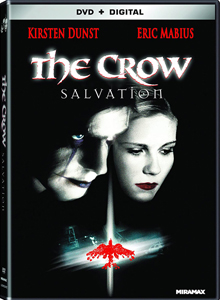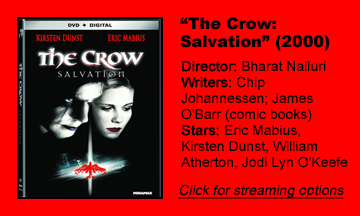“The Crow: Salvation” (2000) is the third straight “Crow” film where I see objective filmmaking and storytelling problems, yet I still kind of like it. In fact, this one has the most coherent narrative so far, and for the first time it makes it clear – “clear” being a relative term – that the crow (as in the bird) is a familiar of the human Crow, and that the human Crow can also turn into a crow if need be.
New team, same vibe
Although the filmmaking team has changed — Bharat Nalluri directs and “Millennium’s” Chip Johannessen writes — we once again have a movie for 1990s Goths who feel like their first love is the only thing that matters in the world and who drown their perpetually sad heart in Rob Zombie, Filter, Hole, etc.
Nalluri brings a music-video aesthetic and the end credits include snippets of four songs for the sake of pushing soundtrack CD sales.
I don’t mean any of this as snarky criticism. “Salvation” has a target audience and it squarely hits that target. And — even though I don’t have an aching desire to revisit any “Crow” film — I enjoyed spending time in this world again. No other superhero saga looks quite like this.
As for the story, Johannessen adds a mystery to the standard revenge format; he’s not as interested in big-ticket action. Alex Corvis (a sympathetic, soft-spoken, smirking Eric Mabius) is electrocuted by the state for the murder of his girlfriend, Lauren (Jodi Lyn O’Keefe).
We can tell he’s innocent long before the film informs us, because it’s a “Crow” picture. The flashbacks, shot like a sunny but grainy music video and backed by Marco Beltrami’s love theme, effectively show us that Alex and Lauren adored each other in that dewy, nothing-else-matters fashion. It’s honestly kind of sweet.
A post-rational world
“The Crow” films stumble on details sometimes, and in “Salvation” the oddity is that no one recognizes Corvis as the Crow even though he looks exactly the same. After his face is fried in the execution and then heals because of his Crow powers, he basically looks like he’s come off of a hard night of partying. The face paint is understated.
Yet Lauren’s sister, Erin (Kirsten Dunst, later of “Spider-Man,” and thus an early example of an actor landing two superhero franchise roles), thinks the Crow must be a friend of Alex’s, since he looks similar. To be fair, she thinks Alex is dead, but her rationalization is rather goofy.
“Crow” characters live in an apocalyptic, post-rational world, but none of them know it till it hits them over the head. We have to wade through the obligatory scene of Erin disbelieving Alex’s claim that four corrupt cops killed Lauren and framed him. (They could’ve killed him too and been done with it, but then there wouldn’t be a movie. Again, I’m not meaning to be overly snarky. I accept that a frame-job is how things work in the “Crow” world.)

But eventually Erin gets on board, and Dunst slots in pretty well as the depressed heroine. She is the biggest name by today’s reckoning, although Walton Goggins (“Ant-Man and the Wasp”) – who has had steady work since – is also recognizable. Otherwise, it’s a lot of guys who look like B-list equivalents to A-list actors.
As Alex works his way down a (literal) list of corrupt cops and learns the details of why they offed his girlfriend, this is pure revenge catharsis, and it all looks great.
Dressing up Salt Lake City
Surprisingly filmed in Salt Lake City, “Salvation” effectively gives us steamy allies, strip clubs bathed in black and white with red in the background, and office buildings that look like they’d be condemned if law enforcement wasn’t busy ganging up on teenagers. And, of course, the Crow’s symbol in blood or flame or whatever’s handy appears at each scene of his vengeance.
I admire the consistency of the first three “Crows.” Yes, the stories are broadly the same, and I do wonder what would happen if the screenplays were a little deeper.
I’m not confident it would still be a “Crow” film in that case; a twisty potboiler might take away from the Crow’s revenge quest and the pain. Johannessen tries little bits of satire here, as with the old lady who loves attending executions as a hobby, but none of it penetrates; “Crow” films tend to snap back to the Crow’s quest.
“The Crow: Salvation” doesn’t shy away from being a style piece for depressed, morose young people. They have music and music videos to escape into, and with this series, they also have 100-minute films. And I’m happy for them.


